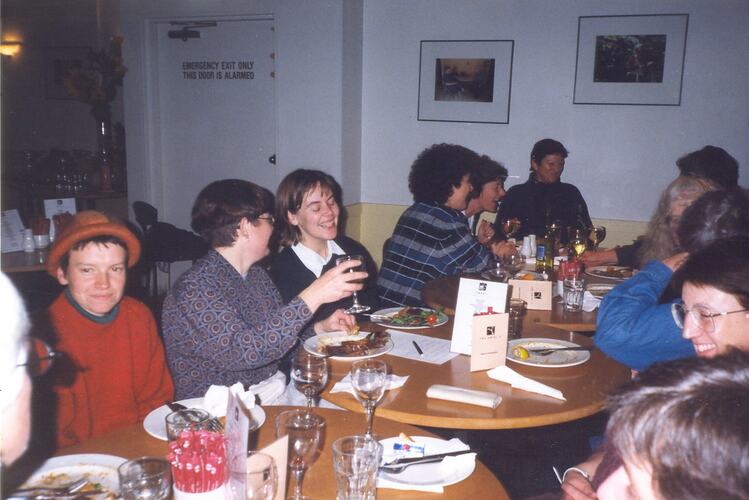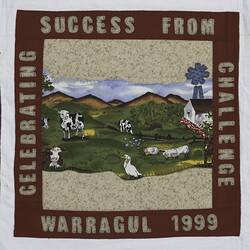Summary
Photograph taken at the 1997 Bendigo Women on Farms Gathering depicting participants enjoying a social chat and a meal during the Friday night dinner. Following registrations on the Friday afternoon, participants of the Bendigo Gathering were entertained on the Friday night by two women's stories and a keynote address by 1996 Victorian Woman of the Year, Lola Miller. Dinners such as this give Gathering participants a chance to catch up with friends made over the years from previous Gatherings, as well as to relax, socialise and share stories away from the pressures of the farm.
Part of Museums Victoria's Invisible Farmer Project Collection. The Invisible Farmer Project was the largest ever study of Australian women on the land, uncovering the histories and stories of Australian women in agriculture. It began as a pilot project (2015-2016) and evolved into a three year (2017-2020) nation-wide partnership between rural communities, academic, government and cultural organisations, funded by the Australian Research Council.
Description of Content
Attendees socialise during the Friday night dinner at the1997 Bendigo Women on Farms Gathering.
Physical Description
Colour Digital Photograph.
Significance
Celebratory dinners are a regular feature of the Victorian Women on Farms Gatherings. During these dinners women feast on local produce and wines and are also entertained with women's stories, speeches and performances, which have included songs, theatricals, fashion parades, comedy skits and dances. Often these performances have carried an underlying message about rural life from a woman's perspective, touching on a range of themes including farm succession, gender equality, community, work, and family life. The celebratory dinners provide an informal occasion for networking, sharing ideas and developing new friendships. They also allow women from across Victoria to relax, rejuvenate and recharge their batteries. Situated in the wider context of the rural women's movement in Australia, these dinners exemplify the importance of communication to the lives of rural women, as well as the varied ways in which women have networked, celebrated their lives and affirmed their rural identities.
More Information
-
Collection Names
-
Collecting Areas
-
Acquisition Information
Donation from Ms Joy Chambers, 05 Sep 2006
-
Place & Date Depicted
-
Place & Date of Event
-
Photographer
-
Format
Digital file, JPEG, Colour
-
Classification
Agriculture & rural life, Community activity - women on farms gathering
-
Category
-
Discipline
-
Type of item
-
Keywords
Conferences, Dinners, Friendships, Rural Women, Women on Farms Gatherings, Gender issues, Rural life, Community groups, Food & Drink Consumption



